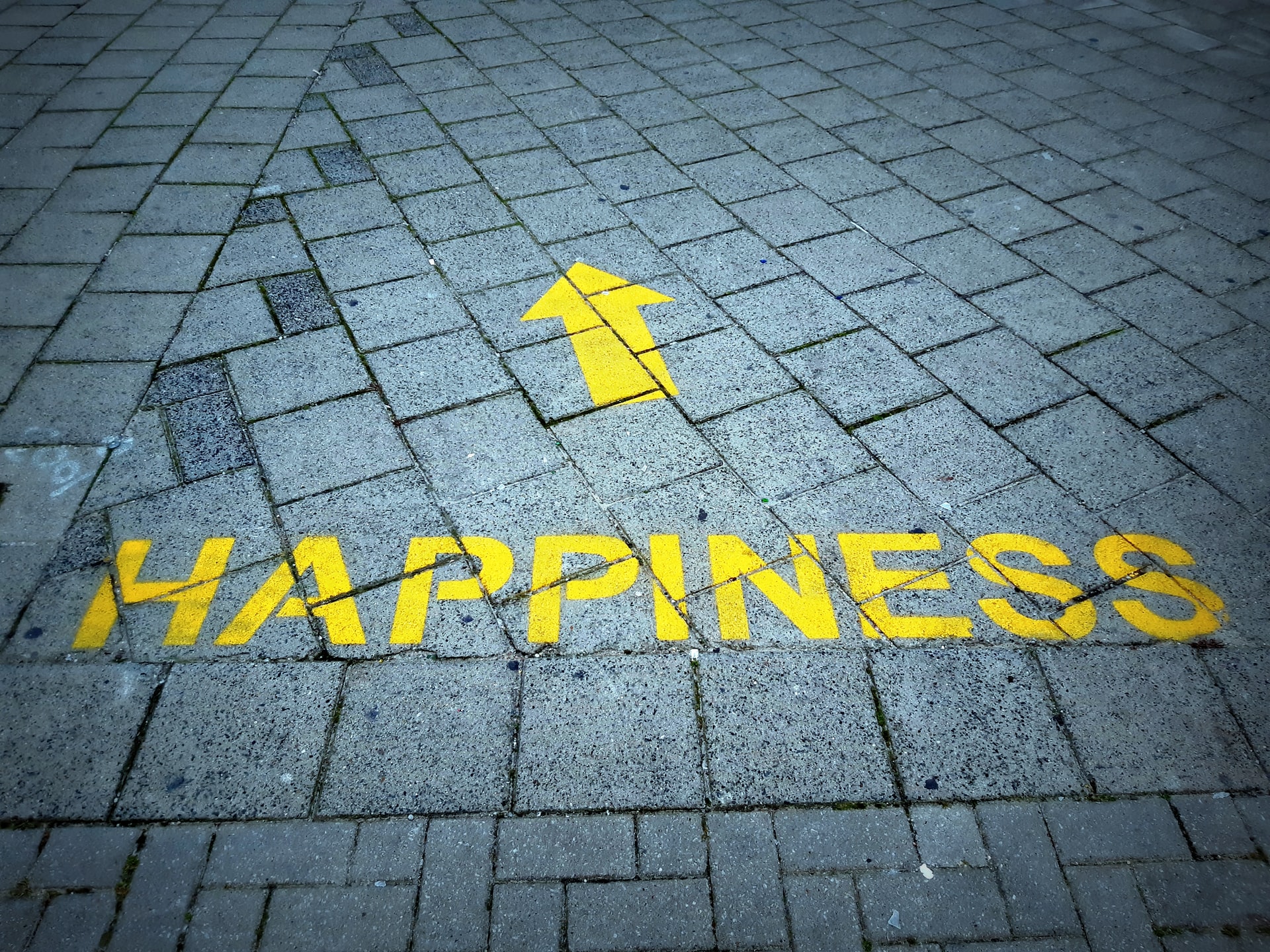
Paul was imprisoned by the Roman Emperor. He was on Death Row. Every morning, when he opened his eyes, he didn’t know if this day would be his last, and whether he would be thrown to the lions or burned.
For most people this would not be their ‘happy place’. In fact, for many people this might be the worst experience they could ever experience in their entire life. It would be fair to assume that Paul’s happiness levels were at an all time low. And yet he wrote an extraordinarily happy letter to his friends in Philippi. In his closing paragraphs Paul shared some of the choices he made that helped him to regain control and experience joy in one of the most challenging of human circumstances.
Recent research into the psychology of happiness and wellbeing has validated Paul’s 1st century insights into joy, and helped us to understand that we can, like Paul, choose happiness wherever we find ourselves. Of course, life on earth is never going to be 100% happy. External events can happen to us and around us and we can experience a wide range of emotions throughout our day, such as fear, joy, gratitude, anger, love, contempt, peace, stress, inspiration, sadness, laughter, guilt, hope, and shame.
Barbara Fredrickson, the author of the book Positivity, researched emotional wellbeing to see what she could learn about helping people to flourish and find true happiness and inner peace, even in adverse circumstances. Her findings are fascinating. The way to have a happy life is not to sit around and be entertained, or to have lots of fame and money. It is about making intentional choices to balance the inevitable draining and negative emotions we experience every day by intentionally choosing 3-4 times as many positive and uplifting emotional experiences. You can even measure your emotional ratio every day using a simple questionnaire at www.positivityratio.com.
The draining, negative emotions are ones that we all experience quite regularly: Anger, guilt, shame, stress, frustration, sadness, contempt, disgust, fear, and embarrassment. These usually make our heart sink. We feel the pain of these challenging emotions, and letting them overwhelm us can prevent us from living our best life. And yet some of them are useful too. Sadness can help us to seek comfort from others, fear can protect us from dangers, frustration can encourage us to solve problems and ask for help, embarrassing experiences can help us grow and learn from mistakes. Even anger can help us to make a stand for right, assert ourselves appropriately, and set clear boundaries with others.
The uplifting and positive emotions are fun and laughter, being filled with wonder, being grateful, having hope, being inspired, experiencing joy, having a hobby or task that consumes all our attention, knowing that our life is worthwhile and valued by others, experiencing serenity, and being kind and loving.
When Paul was on Death Row, he intentionally chose to experience some of the positive emotions that kept him topped up with joy. He knew he couldn’t change his circumstances, but he could change his attitude, and what he focused on. In his letter to his friends, he encourages them to look for the joy in every situation, to live peacefully with each other and sort out their conflicts, to be grateful for the good things in their lives, to be kind and gentle with each other, to focus on the things that are lovely, pure and inspiring, and to praise God. You can find all of these in the fourth chapter of his letter to the Philippians.
Basically, we can’t choose the emotions that we experience in relation to the stuff that life throws in our path. Things happen. We respond almost automatically to them. We may experience all kinds of negative and positive emotions. This is true for the happiest person you encounter, even on their best day. As a result of all these emotions, we then have some choices. . . We can sit and focus on all the negative emotions until they overwhelm us, or we can listen to the wisdom in those feelings that help us to stay safe, get help, set boundaries, deal with past traumas, and find better ways of managing our workloads. We can also choose to experience some of the positive emotions.
When I drive back from a stressful day in the office, I try to rebalance my emotions so that I don’t arrive home with a load of negative feelings. As I travel down the lanes, I look out for natural things that fill me with wonder–like the beauty of the sky or a wildflower. I think of thirty things I’m thankful for. Or I listen to an inspiring podcast, a calming piece of music, or a comedy programme. Maybe I’ll plan a treat to surprise a friend, or think about something I’m looking forward to… Taking time to recognise my emotional level each day, and choosing activities to rebalance it, makes it easier for my emotions to settle into something more positive and peaceful. It’s these small steps that can ultimately work to bring great joy and positive emotional energy into our everyday lives.

Photo by Denise Jones on Unsplash
Here are some simple ways to experience more of the positive emotions. Add your own ideas to the list, too. The simpler your ideas, the easier it will be to experience positive and rebalancing emotions every day and push away the bad habits that we may have. Big goals are great, but it’s important to acknowledge the work that small self improvement strategies can have in creating happy people
- Fun and laughter. Focus on good humour, laughing with other people and not at them. Watch funny videos of animals, tell each other your funniest memories, play a game that everyone enjoys, or watch a good comedy show.
- Wonder. Take a long, slow look at something natural, such as a flower, tree, insect, your own hand, or a sunset. Look for the details you haven’t noticed before and be amazed at the incredible way God has created it. Learn more about something that fills you with wonder by watching a documentary film or reading a book.
- Gratitude. Go through the alphabet and list one thing you are thankful for beginning with each letter, walk into a room and thank God for ten things in the room that you have never thanked Him for before, or write a thank you card to a friend, You could also find a fun and creative way to thank somebody by spelling out the words with their favourite candies, giving a small gift, or recording a grateful a video message.
- Hopefulness. Plan things to look forward to and invite others to join you so that they have something to hope for, too. Choose to read good news stories rather than sad and traumatic ones. Do something to make the world a better place each day – such as picking up litter, recycling, and donating to good causes.
- Inspiration. Listen to podcasts or read books that inspire you. Make sure that they nurture your positive emotions. Read inspiring autobiographies or encouraging Bible stories. Go to art galleries and concerts.
- Joy. Take 100 index cards and write one thing that brings you joy on each of the cards. It’s not so hard when you think of all the things you like to see, hear, do, feel, taste, etc. Then pick any card and try to experience that joy for at least ten minutes. Notice how the activity makes you feel. Write a sentence about the experience on the back of the card.
- Time with an absorbing hobby or activity. It’s good to have a healthy and absorbing hobby that takes your mind off everything else for a while, such as walking, playing music, reading, doing a jigsaw, baking, volunteering, writing, art, gardening, or woodwork.
- Being valued. List three things you did well each day and let your friends, family and colleagues know that what they do is appreciated and valued, too.
- Serenity. Learn what helps you to calm down. It might be a hot drink, a warm bath, breathing as if you are pretending to blow bubbles, or focussing on a soothing Bible verse. The fragrance of lavender, oranges or freshly baked bread, watching a flickering candle, experiencing a hand massage, or even going for a walk in the countryside can help you to calm down, too.
- Kindness and love. Showing kindness to others is one of the best ways to experience happiness. Look out for others who may be going through a hard time, or who need some help. Make cookies to share at work. Spend time listening to lonely people. Be generous. Use whatever you are good at to bless others.
Maybe it all sounds too simple, and perhaps you’re still sceptical. So just experiment with this concept for a week. Whenever you begin to feel your negative emotions piling up and dragging you down, try doing what Paul did, and choose to experience some of the positive emotions. You’ve got nothing to lose, and you might, like him, experience incredible joy, whatever your circumstances.
A version of this article first appeared on ST Network, the European version of Signs of the Times, and is republished here with permission.
Karen Holford is a family therapist with a background in occupational therapy and developmental psychology.













